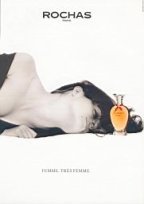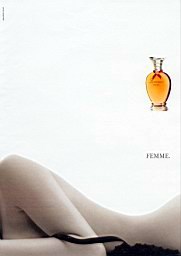Rochas – Femme
 It is said that Grasse in Southern France is the farthest point north at which jasmine can grow. As a result, the jasmine from the region is reportedly shorter in stature than most varieties, but the quality of its fragrance is more potent. While none of us inherently enjoy hardship or strife, it is sometimes under the pressure of external forces that humans manifest their most inspired creations.
It is said that Grasse in Southern France is the farthest point north at which jasmine can grow. As a result, the jasmine from the region is reportedly shorter in stature than most varieties, but the quality of its fragrance is more potent. While none of us inherently enjoy hardship or strife, it is sometimes under the pressure of external forces that humans manifest their most inspired creations.
The 1940s were an era characterized by conflict the likes of which the world hopes to never see again. While the decade was largely dominated by WWII and its aftermath, the latter half of the decade also saw several civil wars, struggles for independence and the Arab-Israeli war.
While the citizens of the world lost much of their former innocence during this time, they rebounded with sweeping advances, evidence of the strength of the human spirit. The United Nations was born from the ashes of the ineffectual League of Nations and huge advances in science were achieved. The 1940s saw the advent of computers, nuclear power and jet propulsion. On a more mundane level, new inventions such as Velcro, television, Tupperware and the microwave oven all appeared on the horizon, changing the way we would manage our lives forever. Abstract Expressionism was born, as we struggled for a way to re-conceptualize our world. The ravages of war were too sharp not to be felt, and life needed to be viewed through a new lens if any sense was to be made at all.
There were, also during this time, acts of sheer beauty. Edmond Roudnitska created Femme in 1943, in the midst of the ruins of war-torn Paris, then besieged by German occupation. It is supremely fitting that Femme was created in what is arguably one of the most beautiful cities in the world, at a time of extreme and powerful emotion. It is as though the fragrance embodies all of the intensity of its time.
Femme speaks of the beauty of a woman in all her facets, the sublime, the sexual, the beautiful, the bold and the vulnerable: because every woman is each of these things. Femme is at once elegant and provocative, but above all expresses a respect and reverence for woman. It is a beautiful and emotional fragrance which conveys a certain vulnerability as well. It is as though Roudnitska was able to read the soul of a woman in all its complexity and distill it into a plush, velvety essence. I am deeply moved every time I smell it and am inspired by the spirit of the man who sought and created such beauty when the world seemed intent on revealing its basest qualities.
Femme has a warm enveloping presence, often likened to the smell of warm skin. Despite a spicy floral opening, the most prevalent note throughout is plum, which is harmonized and softened by wood and musk notes. While Femme conveys the richness of lush, ripe fruit, it does so in a manner strikingly different to the overly-sweet interpretations common in modern compositions. This is the spicy fruit of winter, not the syrupy, sugary fruit of summer. The scent is that of a woman, not of a girl. The depth of the composition is what I find most striking. While the sillage is potent, it is comfortable and yet I always have a three-dimensional experience of Femme. I can almost see it wafting, rising from my arm as one sees smoke rising from a high tower.
Note: Femme was re-formulated in 1989 by Olivier Cresp, the nose behind Thierry Mugler’s Angel. Part of this reformulation included the introduction of a cumin note in the opening over which there has been much debate. While I prefer the original Femme and guard my tiny vintage bottle like a treasure, I do also enjoy the peppery spark that cumin lends it. There has been much speculation over why the formula was changed in this manner. Some surmise it was a desire on Cresp’s part to bring Femme into the present and make it once again memorable and provocative. I can only offer my own impression and interpretation. The first time I smelled Shiseido’s Feminite du Bois, I was delighted to find the outline of Femme, now transformed into a woman of the eighties. A bit leaner, a bit drier for the years, but still magical. Feminite du Bois is silk where Femme is velvet. The first time I tested the reformulated Femme I was reminded not so much of the original Femme in the opening (though I find more similarity in the dry down) but more so of Feminite du Bois, as the cumin renders the overall composition drier and thinner than the original. And so the reference comes full circle.
Chypre
Notes: bergamot, peach, prune, rose, immortelle, jasmine, ylang-ylang, ambergris, musk, oakmoss, sandalwood. Femme may be purchased from many online discount retailers, as well as certain stores. I acquired my vintage version on Ebay.




Pingback: Guerlain – Mitsouko | Quintessence
Pingback: Faun by Ravel | Quintessence
Pingback: Guerlain – Nahéma | Quintessence